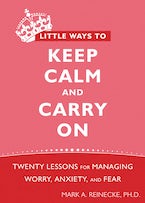By Mark A. Reinecke, PhD, author of Little Ways to Keep Calm and Carry On
One thing is for sure: in this age of COVID-19, we are worried.
We have good reason to worry. We worry about the virus hurting our families and friends, worry about our jobs, our businesses. We worry about toilet paper supplies! Worrying about these problems, and their effects on ourselves and our families, comes at a cost. Dwelling on problems for extended periods of time can leave us feeling depleted, depressed, discouraged, and helpless.
So, how do we handle the rumination, the “flying monkeys,” and make our minds calm? Some of us are in the midst of social isolation which makes the days difficult. Worrying also interferes with sleep, and sleep deprivation affects our health.
Little Ways to Keep Calm and Carry On was written at the height of the Great Recession. Once again, the time is right to revisit the lessons. The chapter below, called “Worrying is Highly Overrated,” is so timely, so needed.
Briefly, the chapter gives you important tools for turning your worrying mind into a solution-focused mind. It teaches a “growth mind-set.” That through this very trying time, you might even build a new set of skills and abilities. You will have an “I can” and “I will” mentality that will make these very difficult days ones you will look back on and think, not just “I survived,” but “I’m stronger.” This is the heart of resilience, a lesson that will make the days ahead even better.
Worrying Is Highly Overrated
I have been through some terrible things in my life, some of which actually happened. —Mark Twain
Did you know that most people believe worrying is helpful? Many believe that pondering a problem long enough gives you a better answer, helps you arrive at a better outcome, provides greater insight, or offers you greater confidence in your chosen course of action. They believe worrying helps you avoid problems and stay organized. They view worrying as an effective motivator and feel that it helps you sort out issues. They believe that worrying helps you cope and makes you wiser and more reflective (Borkovec, Hazlett-Stevens, and Diaz 1999).
From this perspective, worrying is a good thing. In fact, it’s a very good thing. As we’ve seen, however, excessive worrying can be truly destructive (Davey and Wells 2006). Furthermore, the belief that constant worrying is useful is largely unsupported. It’s simply not true.
Two types of worry exist: productive and unproductive.
First, let’s understand productive worry. If the light on your car’s dashboard indicates an empty tank, then your concern about running out of gas is warranted. But if you think for a moment to recall the whereabouts of the closest gas station, go there, and fill the tank, your concern vanishes. Along the same lines, if you forgot to pick up your dog from the groomers and they close in five minutes, a bit of concern is in order. But if you make a call to the groomer, say you’re on the way, pick up the dog, and tip more than the usual amount, this worry goes away. In both of these scenarios, worry or anxiety leads to solving the problem by taking effective action. You replace worry with a plan.
But unproductive worry is somewhat different. The worry doesn’t lead to an action plan. As a consequence, there’s an almost constant twitter of negative, disruptive thoughts. When frequent and compelling, these thoughts can lead to a temporary mental paralysis. Have you ever had days when you just weren’t productive, when you couldn’t get anything meaningful done, so you just pushed piles around on your desk, had trouble focusing, and felt short tempered? Chances are, you were doing a bit of unproductive worrying. Most worrying touches on one of three areas: work, career, or school performance; health; or relationships—all of which are important concerns. It’s natural for us to worry if one of these areas of our lives is threatened.
What can you do? Identify the problem and engage in some solution-focused thinking. Remember, the difference between productive and unproductive worrying is simply whether you can identify a solution. But if there’s nothing you can do to solve the problem, disengage from it and let the worrisome thoughts float away.
Key Points
- There are two kinds of worry: productive and unproductive.
- Unproductive worry can be very unpleasant and is accompanied by high levels of anxiety and loss of focus on even simple tasks.
- The difference between productive and unproductive worry is simple. Productive worry results in an action plan, whereas unproductive worry just causes you to mull a problem over without coming to a solution.
- Identify whether or not the problem truly has a solution you can implement. If you do not have any influence or control over the outcome, you have to relinquish control and let the thought “float away.”
What You May Be Thinking
This ruminating and worrying feels uncontrollable. It’s really rattling my cage. It just has a life of its own and takes my brain hostage.
Now Ask Yourself…
- How do you feel when you find yourself worrying unproductively over a situation that has no apparent solution? Come up with five or so words to describe how this makes you feel.
- What effects, if any, does unproductive worrying have on your relationships with others?
- Can you remember a time when you identified a solution to a situation and the worrying subsided?
- Taking this a step further, can you think of a time when you simply let an unproductive worry go and the situation eventually sorted itself out on its own, or a solution presented itself later on?
What You Need to Do
- Keep in mind that you can control the worry process. Set aside a specific time period each day to worry (say, 8:00 to 8:30 p.m.). During this period, set your mind against your problems. Write down all of your thoughts and concerns, and allow yourself to reflect, or even dwell, on them. Focus carefully and intently on your problems.
- Then, at the end of your half-hour reflection period, write down your answer to the following question: what is the solution? You may have several solutions, which is better than just one.
- Now, set your problems aside. Do something relaxing or enjoyable. Come back to your problems tomorrow at the same time. By taking these steps, you’re on your way to channeling your worry into productive, solution-focused thinking. You’re also demonstrating to yourself that you control your rumination process. With practice, you can start it and stop it at will.
- Just remember, for problems where there’s no answer or solution, let the problem “float away.” No amount of thinking will change a problem over which you have no control or influence.
Mark A. Reinecke, PhD, is professor of psychiatry and behavioral sciences, and chief of the division of psychology at Northwestern University’s Feinberg School of Medicine. He is a distinguished fellow and past president of the Academy of Cognitive Therapy, a diplomat of the American Board of Professional Psychology, and a fellow of the American Psychological Association and the Association for Psychological Science. He lives in Chicago, IL.



 2024 Peace Playbook: 3 Tactics to Avoid Clashes with Your Partner
2024 Peace Playbook: 3 Tactics to Avoid Clashes with Your Partner